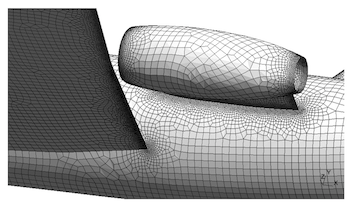

Each line gives the coordinates for a single grid vertex. Immediately after the node number specification comes the list of node coordinates in cartesian space. In this case, there are 9 nodes in the 3x3 square above. For the 2D square mesh, the dimension is defined as follows: As a note, for 2D simulations, it is recommended that a truly 2D mesh is used (no z-coordinates) rather than a quasi-2D mesh (one or more cells deep in the third dimension with symmetry boundary conditions). su2 mesh declares the dimensionality of the problem. The node and element numbering for SU2 start at 0. Square Mesh Example: Note that the figure uses Tecplot node and element number (1-based). SpecificationĬonsider the following simple, 2D mesh for a square domain consisting of 8 triangular elements. Lastly, the boundaries of the mesh, or markers, are given names, or tags, and their connectivity is specified in a similar manner as the interior nodes.

The connectivity description provides information about the types of elements (triangle, rectangle, tetrahedron, hexahedral, etc.) that make up the volumes in the mesh and also which nodes make up each of those elements. As an unstructured code, SU2 requires information about both the node locations as well as their connectivity. su2, and the files are in a readable ASCII format. The SU2 mesh format carries an extension of. A description of the mesh and some examples are below. The format is meant to be simple and readable. In keeping with the open-source nature of the project, SU2 relies mostly on its own native mesh format.
GMSH VERION 2 ASCII HOW TO
Details on how to create and use these mesh formats is given below. A converter from CGNS to the native format is also built into SU2. CGNS support can be useful when it is necessary to create complex geometries in a third-party mesh generation package that can export CGNS files. Limited support for the CGNS data format has also been included as an input mesh format. SU2 mainly uses a native mesh file format as input into the various suite components. points ) def _fix_shape ( data ): if data. """ filename = get_default ( filename, self. values are Structs with name repeated, mode ('vertex' or 'cell') and the data itself. cache: has no effect Returns - out : dictionary Data loaded from file, keys are names. node_groups Parameters - step: has no effect filename : string, optional The file name to use instead of self.filename. vertex data with name "*:ref" to mat_id resp. def read_data ( self, step, filename = None, cache = None ): """ Renames cell resp. file_format in : point_sets, cell_sets = None, None cgroups = cell_data = cgroups return coors, cells, point_data, point_sets, cell_data, cell_sets cell_groups ) for k in cell_data_keys : cell_data. append ( meshio_Cells ( inv_cell_types, conns )) cidxs = nm. From _future_ import print_function from _future_ import absolute_import import sys from copy import copy from io import StringIO import numpy as nm from distutils.version import LooseVersion from import ( complex_types, dict_from_keys_init, assert_, is_derived_class, ordered_iteritems, insert_static_method, output, get_default, get_default_attr, Struct, basestr ) from import ( skip_read_line, look_ahead_line, read_token, read_array, pt, enc, dec, edit_filename, read_from_hdf5, write_to_hdf5, HDF5ContextManager, get_or_create_hdf5_group ) import os.path as op import six from six.moves import range import meshio as meshiolib try : from meshio import CellBlock as meshio_Cells # for meshio >= 4.0.3 except : from meshio import Cells as meshio_Cells # for 4.0.3 > meshio > 4.0.0 _supported_formats = for ii, desc in enumerate ( descs ): cmesh = mesh.


 0 kommentar(er)
0 kommentar(er)
